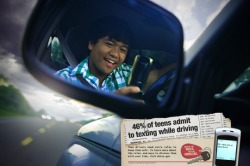Cell phones and texting

Reading or writing a text message behind the wheel can double a driver’s reaction time.
According to a new study released by the Texas Transportation Institute, texting while driving basically doubles a driver’s reaction time and makes the driver less able to respond to sudden roadway dangers, if a vehicle were to make a sudden stop in front of them or if a child was to run across the road.
This is the first published study in the U.S. using actual drivers, rather than simulators. Studies have been confined to simulators in the past for safety concerns.
Researchers studied 42 drivers between the ages of 16 and 54 on a test-track driving course in vehicles equipped with a flashing light and a monitoring system. To put the findings in context, drivers going 60 mph travel farther than the length of a football field in four seconds. (60 mph = 88 feet per second)
If you’re on a freeway where the speed limit is 60 mph in rush hour and a vehicle suddenly stops in front of you, that is not enough time to react if your eyes are glanced down at your phone.
Drivers in the study were more than 11 times more likely to miss the flashing light altogether when they were texting. The study also found texting impaired the ability of drivers to maintain proper lane position and a constant speed.
Texting and driving has already been deemed dangerous, with 34 states adopting texting and driving bans. The Texas Legislature approved a texting ban in 2011, but Gov. Rick Perry vetoed the measure, calling it an “overreach” and a “government effort to micromanage the behavior of adults.” Texas law does ban cellphone use in school zones and includes restrictions for drivers under the age of 18.
In 2009, nearly 5,500 people died and half a million were injured in crashes involving a distracted driver, according to figures from the National Highway Traffic Safety Administration. Distraction-related fatalities represented 16 percent of overall traffic fatalities in 2009, the agency said. It is unclear how many of those fatalities can be blamed specifically on texting.
Source credit: www.washingtonpost.com
According to a new study released by the Texas Transportation Institute, texting while driving basically doubles a driver’s reaction time and makes the driver less able to respond to sudden roadway dangers, if a vehicle were to make a sudden stop in front of them or if a child was to run across the road.
This is the first published study in the U.S. using actual drivers, rather than simulators. Studies have been confined to simulators in the past for safety concerns.
Researchers studied 42 drivers between the ages of 16 and 54 on a test-track driving course in vehicles equipped with a flashing light and a monitoring system. To put the findings in context, drivers going 60 mph travel farther than the length of a football field in four seconds. (60 mph = 88 feet per second)
If you’re on a freeway where the speed limit is 60 mph in rush hour and a vehicle suddenly stops in front of you, that is not enough time to react if your eyes are glanced down at your phone.
Drivers in the study were more than 11 times more likely to miss the flashing light altogether when they were texting. The study also found texting impaired the ability of drivers to maintain proper lane position and a constant speed.
Texting and driving has already been deemed dangerous, with 34 states adopting texting and driving bans. The Texas Legislature approved a texting ban in 2011, but Gov. Rick Perry vetoed the measure, calling it an “overreach” and a “government effort to micromanage the behavior of adults.” Texas law does ban cellphone use in school zones and includes restrictions for drivers under the age of 18.
In 2009, nearly 5,500 people died and half a million were injured in crashes involving a distracted driver, according to figures from the National Highway Traffic Safety Administration. Distraction-related fatalities represented 16 percent of overall traffic fatalities in 2009, the agency said. It is unclear how many of those fatalities can be blamed specifically on texting.
Source credit: www.washingtonpost.com